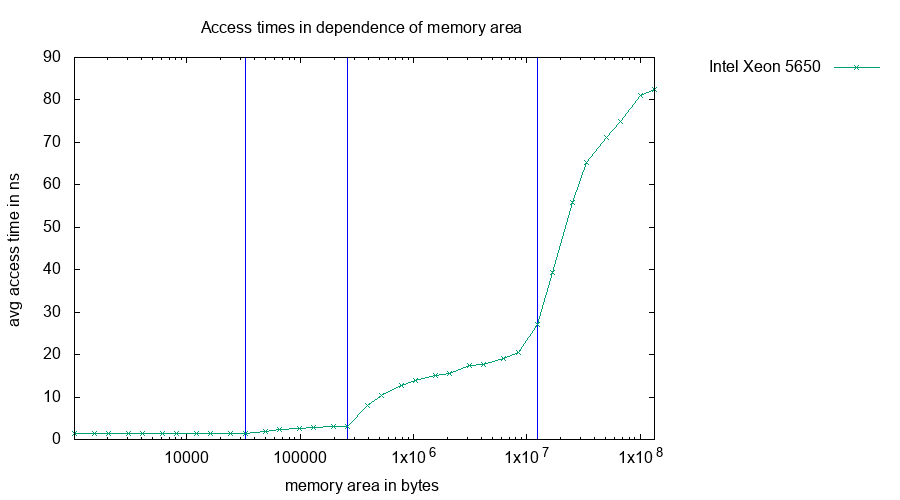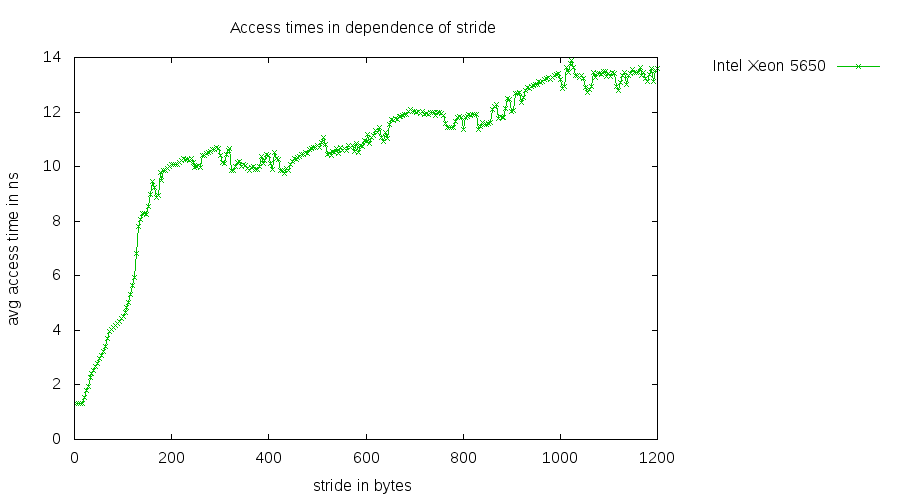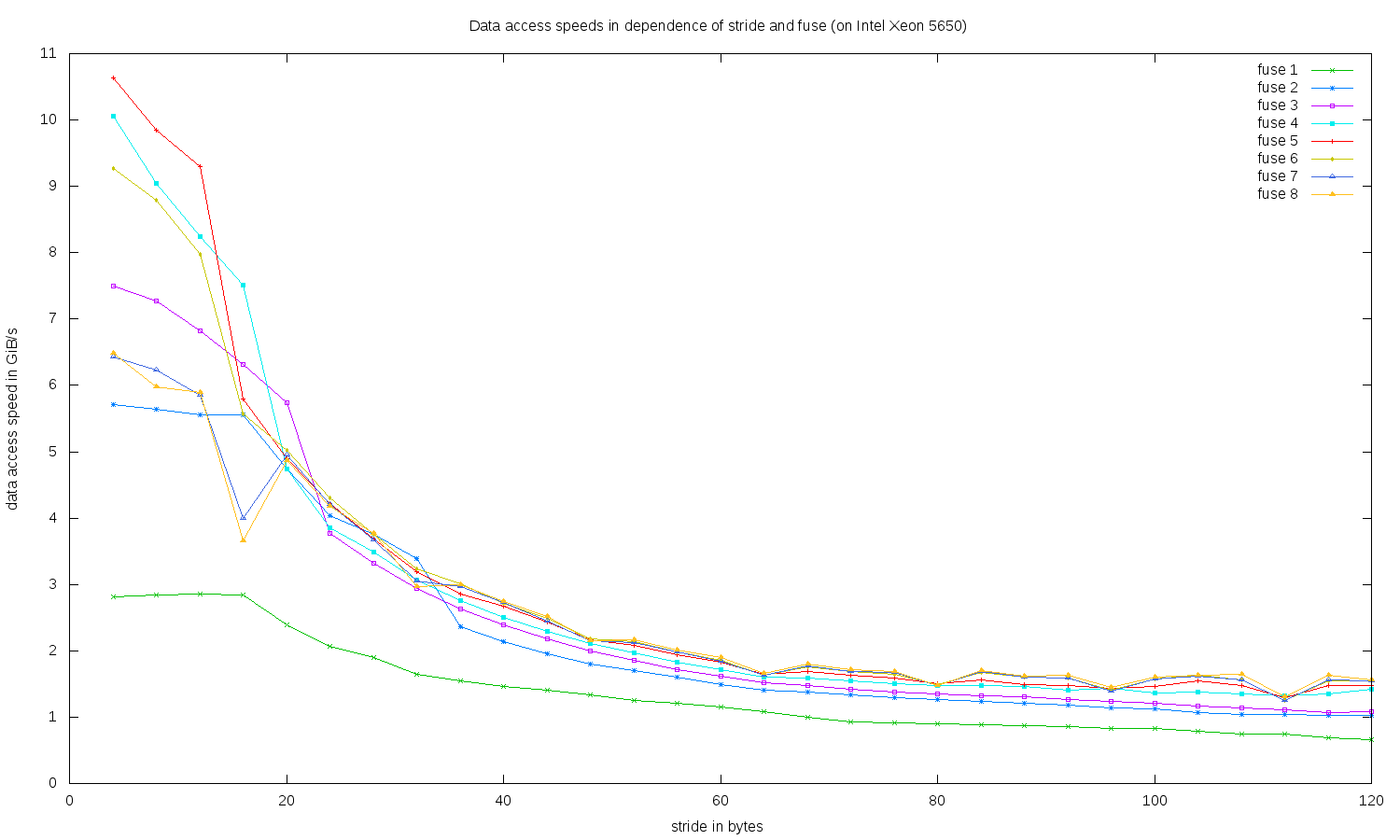Utilities to measure read access times of caches, memory, and hardware prefetches for simple and fused operations
This package provides the following three utilities:
- random-chase: measure average read access times of all cache levels and main memory
- linear-chase: measure read access times for a linear access pattern with a constant stride
- fused-linear-chase: like linear-chase but for an interleaved access pattern of multiple linear sequences, all with the same stride
All of them work with memory buffers that are organized as an array of pointers where
- all pointers point into the very same buffer, and where
- beginning from any pointer all other pointers can be reached following the pointer chain, and where
- all locations are reached.
Once such a memory buffer has been set up, we measure the time of
void** p = (void**) memory[0];
while (count-- > 0) {
p = (void**) *p;
}The p = (void**) *p construct enforces all memory accesses to be
serialized, i.e. the next access can only be scheduled by the processor
when the previous fetch has been finished. To defeat optimizers who
tend to optimize the loop away when the result isn't used, the last
pointer value is assigned to a volatile global variable which is
otherwise unused.
In case of fused-linear-chase multiple such buffers are configured in dependence of the fuse factor.
For the sake of simplicity, all utilities are parameterized through preprocessor macros.
The idea of pointer chasing is not new, in fact there exist quite a number of papers and other utilities related to it.
Following preprocessor macros allow to configure this utility:
- MIN_SIZE: Minimal buffer size in bytes which should be small enough to fit comfortably into the L1 cache.
- MAX_SIZE: Maximal buffer size in bytes which should be larger than the L3 cache.
- GRANULARITY: All powers of two between MIN_SIZE and MAX_SIZE are tested. The granularity specifies how many sizes are tested in-between. For a granularity of n > 0 we get 2^{n-1} sizes in-between.
The output consists of a header line and then a line for each tested buffer size from MIN_SIZE to MAX_SIZE where the memory size and the measured access time in nanoseconds is given.
This is the sample output for an Intel Xeon 5650 with three caches (L1: 32 KiB, L2: 256 KiB, L3: 12 MiB) with default parameters, i.e. MIN_SIZE = 1024, MAX_SIZE = 32 MiB, and GRANULARITY = 1:
memsize time in ns
1024 1.36904
1536 1.35973
2048 1.36904
3072 1.35973
4096 1.35973
6144 1.36904
8192 1.35973
12288 1.35973
16384 1.35973
24576 1.37836
32768 1.36904
49152 2.06754
65536 2.43075
98304 2.79397
131072 2.97092
196608 3.14787
262144 3.29688
393216 8.37259
524288 10.85922
786432 13.20615
1048576 14.38893
1572864 15.59965
2097152 16.23295
3145728 18.08628
4194304 18.34705
6291456 19.79060
8388608 22.66839
12582912 31.55321
16777216 43.27856
25165824 59.39975
33554432 64.04705
A gnuplot script may be helpful to visualize this:
set terminal png size 900, 500
set output "random-chase.png"
set xlabel "memory area in bytes"
set logscale x
set ylabel "avg access time in ns"
set title "Access times in dependence of memory area"
set key out
set pointsize 0.5
# determine maximal y value by plotting to a dummy terminal
set terminal push
set terminal unknown
plot "random-chase.out" using 2
set terminal pop
# mark L1, L2, and L3:
maxy = GPVAL_Y_MAX
l1 = 32
l2 = 256
l3 = 12288
set arrow from l1*1024,0 to l1*1024,maxy nohead lc rgb 'blue';
set arrow from l2*1024,0 to l2*1024,maxy nohead lc rgb 'blue';
set arrow from l3*1024,0 to l3*1024,maxy nohead lc rgb 'blue';
plot "random-chase.out" using 1:2 with linespoints lt 2 title "Intel Xeon 5650"Result:
Following preprocessor macros configure this utility:
- MIN_STRIDE: Minimal stride value. By default,
sizeof(void*)is taken. - MAX_STRIDE: Maximal stride value.
The output consists of a header line and then a line for each
tested stride value from MIN_STRIDE to MAX_STRIDE in
steps of sizeof(void*) and the measured acess time in
nanoseconds.
This is a sample output for the same Intel Xeon 5650
compiled for an 32-bit address space, i.e. sizeof(void*) == 4
which has been shortened for brevity:
stride time in ns
4 1.30385
8 1.31316
12 1.31316
...
1188 13.57868
1192 13.10371
1196 13.52280
1200 13.58800
A gnuplot script may be helpful as before:
set terminal png size 900, 500
set output "linear-chase.png"
set xlabel "stride in bytes"
set ylabel "avg access time in ns"
set title "Access times in dependence of stride"
set key out
set pointsize 0.5
plot "linear-chase.out" using 1:2 with linespoints lt 2 title "Intel Xeon 5650"Result:
Like linear-chase, the macro parameters MIN_STRIDE and MAX_STRIDE are supported. The range of tested fuse factors extends from 1 to 8. This test allows to analyze how many interleaved access patterns with a constant stride are supported by the hardware prefetch.
The output is a table with a column for each fuse factor from 1 to 8 and a line for each stride value tested between MIN_STRIDE and MAX_STRIDE. For each combination the aggregated data access speed in GiB/s is given. There are three header lines.
This is a sample output for the very same Intel Xeon 5650 as above:
data access speeds in GiB/s
fuse 1 2 3 4 5 6 7 8
stride
4 2.81690 5.71429 7.50000 10.06289 10.63830 9.26641 6.42202 6.47773
8 2.83688 5.63380 7.27273 9.03955 9.85222 8.79121 6.23608 5.98131
12 2.85714 5.55556 6.81818 8.24742 9.30233 7.97342 5.85774 5.89319
16 2.83688 5.55556 6.31579 7.51174 5.79710 5.56845 4.00000 3.65714
20 2.39521 4.73373 5.74163 4.73373 4.90196 5.02092 4.95575 4.87062
24 2.07254 4.04040 3.77358 3.85542 4.21941 4.30108 4.20420 4.18301
28 1.90476 3.75587 3.32410 3.48584 3.68324 3.75000 3.66492 3.76471
32 1.63934 3.38983 2.94118 3.07102 3.18979 3.23015 3.05344 2.96571
36 1.54440 2.36686 2.63158 2.76339 2.86123 3.00375 2.96610 2.99345
40 1.45985 2.14477 2.38569 2.50784 2.67023 2.72109 2.73171 2.74914
44 1.40351 1.95122 2.17786 2.29555 2.43902 2.49480 2.44541 2.51572
48 1.33333 1.80180 1.99336 2.11640 2.17155 2.18182 2.14559 2.14909
52 1.25786 1.69851 1.85759 1.96802 2.08551 2.13144 2.13090 2.16802
56 1.20482 1.59681 1.72166 1.83276 1.94553 1.97694 1.98020 2.00501
60 1.15274 1.49533 1.61725 1.72043 1.82482 1.86335 1.84941 1.89798
64 1.08992 1.40351 1.51324 1.60804 1.64339 1.63154 1.63075 1.65889
68 1.00503 1.37694 1.47059 1.58730 1.68209 1.75439 1.76879 1.79574
72 0.93240 1.33556 1.42518 1.55039 1.62866 1.68658 1.68980 1.71306
76 0.90909 1.29450 1.38090 1.49953 1.58479 1.64948 1.67164 1.69223
80 0.89888 1.26582 1.35135 1.47738 1.50038 1.49254 1.47446 1.48285
84 0.88300 1.23267 1.32013 1.47194 1.56617 1.67131 1.68370 1.70758
88 0.87912 1.21581 1.30293 1.46119 1.49477 1.59893 1.59817 1.62025
92 0.85106 1.17820 1.26449 1.40105 1.48038 1.59151 1.59091 1.63016
96 0.83333 1.13636 1.24224 1.43498 1.43885 1.41260 1.39651 1.44993
100 0.82816 1.11888 1.20846 1.36519 1.46520 1.57274 1.56863 1.60966
104 0.79051 1.06809 1.16959 1.38289 1.54440 1.62712 1.61570 1.62850
108 0.74906 1.04439 1.13422 1.35021 1.47384 1.55440 1.56337 1.64271
112 0.74488 1.03896 1.11008 1.31796 1.29955 1.25720 1.24611 1.31201
116 0.68376 1.02828 1.07431 1.34567 1.47820 1.55039 1.55729 1.63850
120 0.66116 1.02960 1.08794 1.41970 1.47601 1.55039 1.54525 1.56479
This can be visualized using a gnuplot script:
set terminal png size 1500, 900
set output "fused-linear-chase.png"
set xlabel "stride in bytes"
set ylabel "data access speed in GiB/s"
set title "Data access speeds in dependence of stride and fuse (on Intel Xeon 5650)"
set pointsize 0.5
plot \
"fused-linear-chase.out" every ::3::32 using 1:2 title "fuse 1" with linespoints lt 2, \
"fused-linear-chase.out" every ::3::32 using 1:3 title "fuse 2" with linespoints lt 3, \
"fused-linear-chase.out" every ::3::32 using 1:4 title "fuse 3" with linespoints lt 4, \
"fused-linear-chase.out" every ::3::32 using 1:5 title "fuse 4" with linespoints lt 5, \
"fused-linear-chase.out" every ::3::32 using 1:6 title "fuse 5" with linespoints lt 1, \
"fused-linear-chase.out" every ::3::32 using 1:7 title "fuse 6" with linespoints lt 7, \
"fused-linear-chase.out" every ::3::32 using 1:8 title "fuse 7" with linespoints lt 8, \
"fused-linear-chase.out" every ::3::32 using 1:9 title "fuse 8" with linespoints lt 9Result:
If you want to clone this project, you should do this recursively:
git clone --recursive https://github.com/afborchert/pointer-chasing.git
To build it, just invoke make. You need g++ supporting C++11 and GNU make for this to work.


